|
|
 |
|
|
The Beginnings of the Waffen-SS: Combat History - Part Two
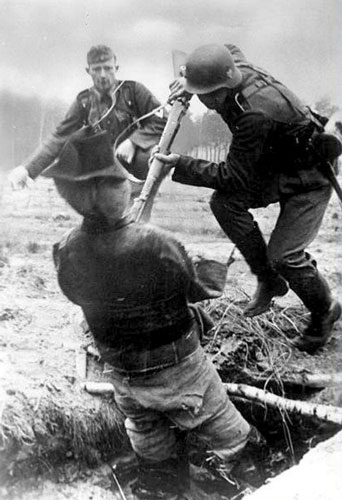 |
The Beginnings of the Waffen-SS Part Two
Combat History
by Andy Blozinski
The invasion of Poland was to finally test the SS-VT in true combat, albeit as separate elements. Regiment Germania was attached to several separate Corps of Army Group South, split up into subunits and parceled out. The SS-VT pioneer battalion was attached to Heer XV Corps of 10th Army of Army Group South. Regiment Deutschland was to be part of a Heer experiment. An early Panzer Division normally had two infantry regiments. The experiment was to try it with a single regiment. The SS-VT artillery regiment, Flak machine-gun battalion, reconnaissance regiment, signals battalions and Regiment Deutschland were attached to Heer Panzer Division Kempf in I Corps of Third Army in Army Group North. Regiment Der Fuhrer was sent to the southern sector of the Westwall facing France to serve as mobile reserve for the Heer organized defense. This dilution was a specific choice by the Heer through agreement with Hitler. There was still an obvious lack of trust.
Read part one, The Formation here...
|
The overall plan for the invasion of Poland was a two pronged encirclement. Each pincer force was also separated into two groups, so it was really four pincers. This was because there were two encirclement objectives in mind. Polish armed forces in western Poland were to be encircled and cut off and Warsaw was to be encircled in a separate effort. The first goal was to aid the other. Army Group south received the lion’s share of forces, especially the more modern Panzer and Mechanised forces as it was going to face a larger portion of the Polish armed forces and also had to cover a lot of distance quickly. It was to push forward into the Polish lines from as far south as Slovakia and then race to Warsaw from the south to circle around it and come at it from the east. The northern elements of Army Group south were to work to encircle elements of the Polish forces.
|
Structure of Combined forces Panzer Division Kempf
- 7th Panzer Regiment
- SS Regiment Deutschland
- SS Artillery Regiment
- SS Signal Battalion
- II/47th Heavy Artillery Battalion
- 505th Pioneer Battalion
- SS Aufklarungs (Recce) Battalion
- 2. Co/SS Anti-Aircraft MG Battalion
- 506th Feldpost Office
- 171st Verwaltungsdienste (Subsistence)
- Bakery Company, Butcher Platoon and Medical Services
|
Germania was diluted amongst this effort of Army Group South as it was split up into elements operating in different parts of the country. Much of their effort was spent performing flank protection for XXII Corps while it pushed into the eastern town of Chelm. The importance and risk of such a mission is not to be underestimated by its title. A company of Germania regiment ambushed a battalion of Polish infantry on the move and managed to take 500 prisoners. It was then nearly over-run by cadets and officers from the Polish Academy at Krakow as they tried to push their way through a protective roadblock to get to Lemberg. A retreat to join up with a second company of SS infantry salvaged the situation. 2nd Battalion operated completely separately with 8th Infantry division of VIII Corps and later joined up with elements of 5th Panzer Division along with its SS-armored recon detachment that had earlier been separated to assist 5th Panzer Division throughout.
|
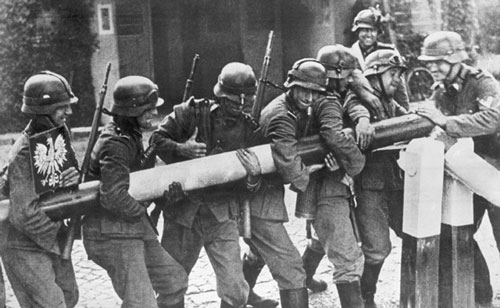 |
Deutschland, paired with panzer Division Kempf, saw its first action on the border of Poland with Army Group North, working its way towards the Warsaw encirclement. The SS infantry spearheaded attacks on two separate villages under cover of artillery barrage to break open the road for advance to their first objective, the seizure of point 192 on a hill on a defensive line at Mlava. The Mlava defensive fortifications were modern, well manned by the Polish 20th Infantry Division of the Modlin Army and prepared well. 20th Infantry had been fully mobilised for some time to man it as a critical approach route for an attempt to encircle Warsaw.
|
While the previous actions went like clockwork and resulted in an
unopposed breakthrough along a rapid road, the entire Kempf division
came to a halt facing an upward slope with little chance for protective
cover and well supported determined defenders in heavily prepared
fortifications. This was not a good position for any force and did not play to the strengths of the training the SS-VT had prepared for, which was to outflank and infiltrate in small unit actions. Repeated unsupported attacks taken immediately from the march with little preparation on a well organised fortified defensive position were unsuccessful. German 1st Army Corps in general was stalled along the Mlava line. The whole force was reset and a coordinated and combined support attack was planned along the line. The well protected Polish fortifications shirked off the preparatory artillery barrage. The Luftwaffe completely failed to arrive. The tank support from 1st Battalion, 7th Panzer Regiment ran into a well laid ambush/tank trap. Rail line anti-tank traps were covered by sited in artillery and anti-tank guns. At the loss of 39 tanks, the tank support was pulled back by its commander, but the infantry was still sent forward without support. SS Regiment Deutschland was, once again, assaulting a fortified line, uphill and in the open with improper preparation. The attack was pressed on under heavy fire to within 150m of the defenses before the attack was called off across the entire line. Deutschland was one of the few units to actually do its job, though.
|
Division Kempf was pulled out and sent 40km east towards Chorzele in a mission more appropriate to its capabilities as a mobile attack/exploitation force. Here a hole had been punched through the lines of the Mazowiecka Cavalry Brigade and the mobile forces of Kempf were sent through the breach. Polish 8th Infantry Division was sent in to plug the gap to no avail. A 48km pursuit ensued until the Poles could reset along another line of defense manned by Polish 41st Infantry Division in some Tsarist fortifications near Rozan along the Narev River. Again, the SS Soldaten were quickly assaulting fortifications in a bad situation. The panzer troops lost 11 tanks and 20 broke down in the process. Both sides were drained in further actions and Division Kempf had to reset into defensive positions to take a counter attack by charging Polish cavalry. This all turned out to be useless expenditure on
both sides as the river was easily flanked further south and the Poles
ended up having to pull out or risk encirclement.
|
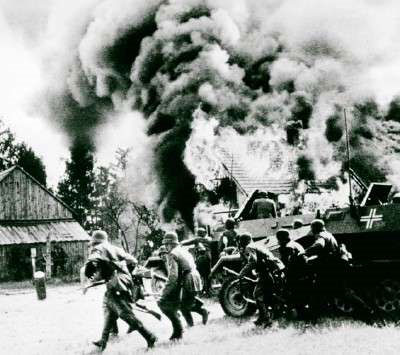 |
For the next two weeks, the bloodied Division Kempf with SS Regiment Deutschland as its infantry complement
participated in a series of pursuits and movements to aid in the
encirclement and cut-off of Polish forces in the west trying to rush
back east to protect Warsaw. The pace didn't allow time for
re-organisation, so it was a bit of a disjointed effort from an
experimental force so recently battered and now operating often as
isolated battle groups. Many of the determined Polish forces made it
through, although German forces were close on their heels and one town
fell after another in rapid succession until, on September 16th, Deutschland worked to close the ring of encirclement on Warsaw. The suburbs were already getting pounded and probed in most directions at this point. There was a line of prepared positions known as the Modlin Line with two strongpoint forts, fort #2 north-east of Modlin and fort #1 north of Zacrozym, manned by 35,000 troops more determined than ever. Although all of Warsaw was now surrounded, Hitler was set on dramatically taking it out from all directions. The siege preparation of Warsaw took a week and gave Kempf a chance to re-organise. A multi-divisional assault on the forts probably was not needed, but it went better this time with proper planning and preparation and was also aided by the fact that the Polish army was starting to collapse at this point. After waved Stuka attacks prepped the area, Deutschland pioneers breached a hole through the barbed wire. Deutschland scouting units moved through and realised there was a weakness in the defences at fort #1. Standartenfuhrer Felix Steiner himself confirmed with his own personal scouting and the plan was set for a sudden assault for September 29th, starting from the positions that had been advanced previously. Deutschland moved to attack through Zacrozym when all operations were suddenly halted for a chance for Polish forces to surrender. When that did not pan out, the artillery preparation began and then the assault resumed with pioneers and flamethrowers spearheading the assault detachments much like the Stormtroopers of World War One. Within an hour and a half, Zacrozym was occupied and formed the central point to assault and take fort #1. With the fort surrounded, artillery was concentrated and focused on it for hours until the defenders gave in and surrendered. Deutschland had completed its final mission for the campaign and the entire line of Modlin defenses surrendered. Deutschland was pulled back as the entire Polish operation wound down to conclusion. Although there had previously been tensions between the Heer and SS-VT, the established military finally got a practical test of its suspected competition and the response was respect. In his report to OKH upper command, General Kempf gave specific compliments to the separate elements of Deutschland that had operated with his troops.
|
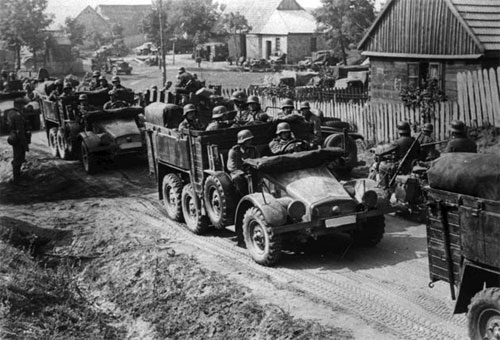 |
Everything connected to the new concept of integrated armor and mechanised forces still needed some work and Poland was the testing ground for further improvement for all German armed forces. Overall, the immediate Heer commanders of SS-VT forces gave positive reports of their cooperative experiences with the SS-VT units. There was a problem with guilt by association with the military performance of the less well trained SS elements, especially the SS-Totemkopfverbande and their other operations in civilian population eradication. Many upper level commanders were also still very suspicious and opposed to any SS military formations.
|
| Only weeks after the capitulation of Poland, the decision was made by
Hitler to form the SS-VT units together to form their own divisional
organisation in which they could operate properly, the SS-Vefugungs
Division. Its composition was officially referred to as a motorised
Waffen-SS division...the first time that term had been publicly used. All the disparate elements were transferred to Czech training grounds
in the Brdy forest east of Pilsen with Generalleutnant der Waffen-SS
Paul Hausser as the divisional commander. One month was spent
organising the divisional structure and forming units for any holes in
the structure. The entire division then returned to Germany. The
SS-'V' Division was still formally assigned to be in Heer control. The
complacency of the Allies allowed the German armed forces several
luxuries during the Sitzkrieg. German forces could be redeployed from
any sector as specifically necessary as needed for maximum efficiency.
Since the Allies were making no offensive moves, it was clear exactly
what the German mission would be and how forces needed to be deployed to
maximum effect. The Germans also had plenty of time to prepare. This
last luxury benefited all German forces greatly. All practical combat
lessons from Poland had time to be thoroughly examined and disseminated
among the ranks and to motivate improvements in structures, tactics and
equipment. The SS-V division reaped the rewards of this downtime to
consolidate itself as a large scale contained functional unit and to
strengthen training. |
In December 1939, the Der Fuhrer Regiment, 2nd Battalion of the artillery regiment, a company of combat engineers and supply support was ordered to the Datteln area of Westphalia to be attached to the 207th Infantry Division under Heer Generalleutnant von Thiedemann in the 18th Army. Intense and task specific training (such as river crossing) over the winter was to prepare this reinforced regiment for its role as the spearhead of the offensive into Holland. At the same time, the divisional recon battalion and an armored car platoon from Deutschland were attached to the Heer 254th Infantry Division (also of 18th Army) to be part of another forward element that would integrate with several Heer battalions for machinegun and artillery support. This second force was broken into 5 assault detachments that were tasked with securing individual bridges to facilitate movement of other forces and was collectively referred to as the Grave Group.
|
The Structure of the first Waffen-SS Division
- Divisional HQ
- SS Motorised Infantry Regiment Der Fuhrer
- SS Motorised Infantry Regiment Deutschland
- SS Motorised Infantry Regiment Germania
- SS Artillery Regiment
- SS Reconnaissance Battalion
- SS Motorised Panzerjaeger Battalion
- SS Anti-Aircraft Battalion
- SS Motorised Pioneer Battalion
- SS Motorised Signals Battalion
|
Holland was prepared to stave off an invasion with multiple layers of bunker fortifications and rivers. The first layer was the Ijssel-Maas river line connecting the cities of Arnhem, Nijmegen and Malden. The second layer consisted of dual constructed fortified lines. The Grebbe line from the Zuider Zee to the river Maas was manned by Dutch II and IV Corps. III Corps manned the similar Peel line extending to the town of Weert. The third layer was a fortified line stretching from Zudzee to Dordrecht and then from Utrecht to the sea, referred to as Fortress Holland. A unique trick up their sleeve was that the extensive dike system could be opened to flood areas to prevent or slow down movement.
The German plan was to drop several paratrooper elements into the interior near The Hague and Rotterdam while the 18th Army moved to link up with them. Speed was of the essence as the paratroopers would need to be relieved and allowing the destruction of bridges and dikes could slow the entire invasion down long enough for Britain and France to react and reinforce against the German forces that were ultimately trying to get into the flank of the Maginot line.
Early morning 10th of May, 1940...the invasion of Holland begins with the paratroop drops. German 22nd Airborne division landing near the Hague was quickly counter-attacked by Dutch I Corps and completely killed or captured. German 7th Airborne Division was successful, having staved off the Dutch counter-attacks to secure multiple critical bridges to open a corridor for German 18th Army to move in force. 5:35am was the jump off time for the detached forward elements from the SS-'V' Division operating to spearhead for the Heer 18th Army. The Grave Group had mixed results. The bridge at Heuman was captured intact. At Hatert, the entire assault detachment was either wounded or killed, but 4 men hung on as the severely mauled Dutch retreated, leaving behind a damaged but intact bridge. The other three assault groups failed to take their bridges before the bridges were destroyed. A pocket of bunkers near Neebosch was taken out, though, and a suitable ford area was secured across the Meuse-Waal canal.
|
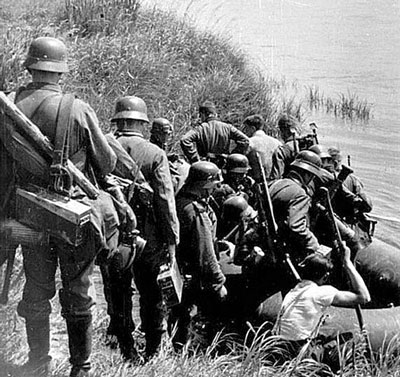 |
II Battalion of Der Fuhrer Regiment, reinforced with additional infantry guns and anti-aircraft guns was the launch force. They were to proceed on foot in pace with their flank protection from 207th Infantry Division. Assault teams overwhelmed the immediate vicinity Dutch border guards. Often assaulting in close quarters, a path was pushed through various roadblocks on the road to the objective town of Babberik to create a breakthrough zone. III Battalion gathered up all nearby bicycles and leapfrogged past II Battalion and pushed through the hole. Despite reaching Arnhem by 7:20am, the bridge across the Ijssel was blown before they arrived. Immediate plans were made within the hour for a river crossing. II Battalion of the SS Artillery Regiment was reinforced with a Heer heavy battery to provide supporting fire. Fort Westervoort on the opposite bank was pounded while anti-tank guns and heavy machine-guns were moved into position to start hitting pinpoint defensive positions.
|
| At 11:00am, the first wave with SS engineer troops crossed 300m of open
ground to cross 150m of river in inflatable boats still under
significant fire. Rapid action was the key as the first lanes were cut
in the barbed wire on the opposite banks by 11:15am. By 12:15pm, III
Battalion was across and then took Fort Westervoort through close
assault. III Battalion pushed directly into Arnhem to secure it while
II Battalion and its engineer company bridging unit got an 8 ton bridge
erected by 4:30pm. No time was to be wasted as III Battalion took 15th
company (on motorcycles) and set out on bicycle in the direction of
Wangeningen. The foot marching elements of Heer 207th Infantry Division that SS
Regiment Der Fuhrer had been attached to had been left behind as III
Battalion reached the fringes of the Grebbe line by 8:30pm. Pause was
taken to properly prepare for a morning assault. 18th Army as a whole
was able to advance 62 miles in the first day due to the rapid success
of the spearheading SS force. This progress caught everyone unawares.
Dutch Army command had figured Fort Westervoort could hold out for three
days. It was taken in four hours. There was a traffic jam for German
18th Army as the entire force hadn't been expected to move that fast.
The remainder of the SS-'V' division was caught between doing flank
security at times and getting caught in the traffic jam and thus saw no
combat. |
The entire Der Fuhrer Regiment was formed into a deep three point V with the battalions as points and Wangeningen was taken by 11:00am on May 11th. The Grebbe line was next. I Battalion and III Battalion were positioned in parallel, slightly offset with II Battalion in reserve. An artillery battalion from Heer 207th Infantry Division was called in for additional support. The Grebbe line was a deeply layered defense with the back line hardened fortifications centered on the Grebbe-Berg hill commandingly overlooking a dense network of hedgerows, trees and forested areas that limited the attacker's view towards the ground level layers of defense, but allowed observers on the hill to sight for artillery down on the attackers and report their movements for coordination. An extensive network of tree mounted snipers also looked down on and harassed any advancing troops. Progress was made slowly and at close range with the infantry often in grenade range, but they reached to within 600m of the fortified supporting portion of the Grebbe line by 7:00pm and a concentration of artillery and heavy weapon fire allowed them to reach the fortifications by 9:00pm and they were poised at the base of the Grebbe-Berg itself. The Grebbe-Berg was proving a tough nut to crack and its commanding presence made a difficult task of moving up inflatable boats.
|
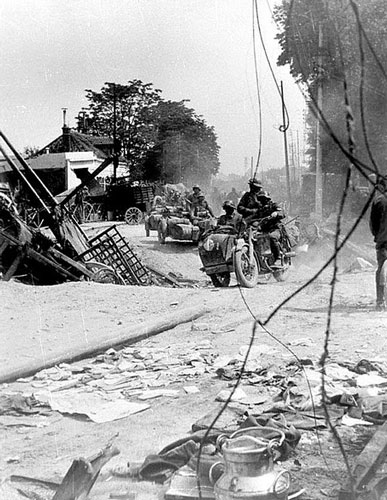 |
The decision was made to pull back and call in
further artillery support from both the 207th Infantry Division and
Corps support as well. After a 20 minute artillery preparation, a
combined infantry and combat engineer force from Der Fuhrer’s III Battalion made a daytime crossing of the Grebbe in inflatable boats on May 12th, while II Battalion assaulted the fort. By 7:00pm, II Battalion was at the peak of the Grebbe-Berg and the river was crossed. A temporary bridge was quickly set across the Grebbe to get heavy weapons across. Heer reinforcements arrived to provide flank security and SS III Battalion set out at 10:00pm past the fallen defense line to secure a rail line east of Rhenen, capturing an entire gun battery in close assault. The next morning was spent rolling up a 1.5 km section of the Grebbe line. Progress had to be halted, though, as Heer infantry guarding their flank were unable to keep up for protection. After a heavy artillery and Stuka preparation, the Heer 322nd Infantry Regiment of the 207th began moving again. By 7:00pm, the rest of the Grebbe line had fallen to Der Fuhrer. They turned towards Rhenen to give aid to Heer 322nd Infantry Regiment taking the town, which fell that night. The Dutch had figured the Grebbe line could be held for at least 2½ months. The fourth formal military regiment formed under the SS banner, Der Fuhrer, breached it three days after crossing the border and collapsed the line a few days later. Dutch forces had been caught quite off guard by the rapid collapse of their fortified defense lines. Heer 9th Panzer division had also breached the southern end of the 3rd line, Fortress Holland, and hooked up with the 7th Airborne Division to relieve them. Heer General Hansen of X Corps was impressed with Der Fuhrer's performance and tasked them with spearheading the assault on the eastern sector of Fortress Holland after DF had rested up. Dutch forces were reeling and collapsing at this point, so it fell rather handily on May 15th and X Corps pushed quickly into Amsterdam.
|
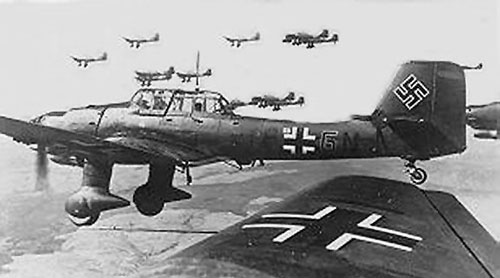 |
The lone hold-out was the island of Walcheren as Dutch forces now capitulated and the royal family evacuated to England. The remainder of the SS-'V' Division had been subject to traffic jams and re-directed orders throughout the conquest of Holland and seen little action. They were now in position and tasked with taking out an ideal defense manned by stubborn defenders. The Beveland peninsula was essentially a single road/rail line, flooded on both sides, which connected to a dam leading to the island.
|
The peninsula was wired, mined and had manned fortifications leading all the way to Walcheren. The island was close enough to Belgium that it was able to get heavy artillery support from Antwerp and also had British naval support from offshore. The German forces countered with 21 heavy artillery battalions and 11 Stuka dive bomber and heavy bomber squadrons. Offers to surrender from the Germans and offers to evacuate by the British were spurned. The narrow flooded peninsula limited the attack force to one battalion at a time on solid ground. 3rd Battalion of Regiment Deutschland was at the forefront as the attack was started along the peninsula on the afternoon of May 16th, with 1st battalion in line behind. Intense naval fire and supporting artillery fire from Antwerp forced the battalions to spread out into the flooded areas. Despite the integrated and prepared defenses, the SS Soldaten pushed relentlessly and engaged in intense assault with the prepared defenders, often using shell holes and wrecked train cars to create cover for their advance. At the cost of 16 dead, they reached the dam. The dam itself was a narrow killing field with little chance for cover, though. The Dutch defenders realised the situation was ultimately hopeless and took advantage of the ideal choke point to effect their escape from the opposite end of the island. Deutschland lost 17 more dead unsuccessfully engaging the delaying force and the Dutch made good their escape via British naval evacuation on May 17th. SS Regiment Der Fuhrer was directed to rejoin the division and the next few days were spent with the various elements of the SS-'V' division moving together near Marienbourg amidst the rush of forces from Heer Army Group B advancing through Belgium and into France.
|
Defending Allied forces in France had been scythed in half as the invading German forces created a salient reaching the English Channel that separated defenders in northern France and Flanders from those along the river Somme. The SS-'V' division was operating under Heer 18th Army now of XIL Corps. On the evening of May 22nd, SS-'V' Division was ordered along with 6th and 8th Heer Panzer Divisions to proceed with haste to firm up flank security of the salient facing the northern defenders and to prevent them from breaking out. SS-'V' was specifically tasked to secure bridgeheads across the La Bassee Canal and push British forces out of the Nieppe forest. Unfortunately, mid transit, the SS-'V' division was ordered to halt and maintain positions as is the night of May 23rd. The haste in movement of all forces meant they were somewhat spread out, scattered and even isolated in some cases around the Divion-St Hilaire area. While the entire division was dealing with problems from scattered enemy elements probing for holes, the SS Regiment Der Fuhrer was to almost immediately suffer a concentrated night time push from massed armored French forces attempting a breakout.
|
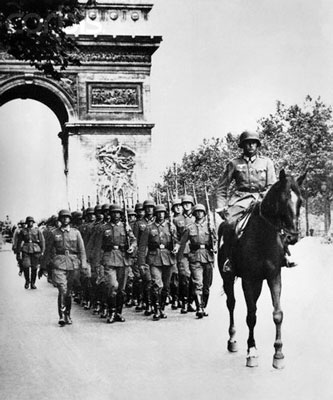
|
9th Company of SS Regiment DF under Hauptstumfuhrer Harmel was over-run by 50 French tanks and a battalion of infantry while 10th and 11th companies were suddenly surrounded. Harmel managed to hold the situation together long enough for III Battalion commander Hauptsturmfuhrer Otto Kumm to arrive with reserves, including an MG platoon from 12th company and a platoon of anti-tank guns from 14th company. Infantry using explosive charges and combining with anti-tank guns managed to inflict terrible losses on the French armor. In less than an hour, 13 tanks were knocked out near the town of St. Hilaire and 400 prisoners were taken. The remaining French forces pushed past and encountered 7th Company under Hauptsturmfuhrer Hans Lingner and 5th company in Aire. The French forces were summarily wiped out in close combat in the streets. Again, bundling grenades and explosive charges, the SS Soldaten were mounting the French tanks, ripping open their hatches and throwing charges into the tanks while the AT guns shot into the flanks of the French armor in close coordination with the infantry. The night was full of chaotic action as II Battalion headquarters billeted with an artillery battalion suddenly had to deploy their guns to engage French armor that they originally thought was German armor moving through. A 30 man motorcycle reconnaissance patrol commanded by Untersturmfuhrer Fritz Vogt with attached anti-tank guns spotted another French armored battalion and ambushed it. First the troop transport and supply vehicles at the tail of the column were picked off and then the tanks at the head were shot up. The sudden and unexpected attack further demoralised the tankers and the French battalion surrendered. Vogt got the Knights Cross of the Iron Cross for this action. The WW I style Stosstruppen training had prepared the Soldaten to use explosives, flamethrowers and company assigned anti-tank guns in assault groups. They quickly adapted this training to the modern threat of tanks and successfully threw back, killed or captured the entire armored breakthrough. The area was secured by the morning of May 24th in this first ever encounter with tank formations by the SS-'V' Division.
|
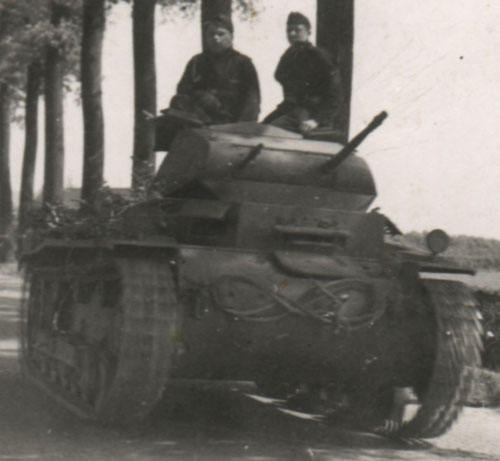 |
Later that same day, the SS-'V' Division proceeded with its original mission. The La Bessee canal was crossed, multiple bridgeheads were set up on the opposite side and the division advanced 8km before encountering a determined counter-attack from British 2nd Infantry Division. Repeated attacks were held off for days with lines being essentially static until the British pulled back. With the bridgeheads now secure on the 26th of May, the division was ordered to attack into the Nieppe forest to clear it of occupying British troops. This was to take some solid work to do. The British had prepared a trench network with fortified hard points in this dense forest with scattered channeling swamp areas. At 8:30 AM on May 27th, SS-'V' Division moved into the forest with Germania on the right flank and DF combined with the recce battalion on the left flank. Germania ran into the Queen's Own Royal West Kent Regiment.
|
A network of tree mounted snipers made progress through the forest slow
and costly for them, but they managed a modest gain to reach the town of
Haverskerque by evening. DF engaged the fortified network in the
dense forest with repeated close assaults and created a deep salient
reaching the Canal de Nieppe that evening. Heer 6th Panzer Division was
supposed to be DFs left flank protection, but they'd lagged behind
and DFs right flank was open because Germania had run into such
effective opposition. The British took the night to probe these open
flanks and for other possible holes to exploit for counter-attacks, but DF still held their ground. Meanwhile Deutschland had forced its
way across the Lys canal on its way to Merville and set up bridgeheads
to prepare a path for follow-up German forces. The SS-Totemkopfverbande
(SS-TV) Division (Not part of the SS-VT) was supposed to be their
back-up but was lagging behind. British armored forces took advantage
of the tenuous bridgeheads and slammed Deutschland. They were
suffering pretty badly as anti-tank assets hadn't been deployed.
Fortunately for them an entire company of AT guns from SS-'TV' arrived
just as the situation became dire and threw back the British tanks. May
28th started off with both sides trading punches to no effect, until
the Belgians announced their surrender. The British strategic flank was
now open and their forces in the Nieppe pulled a large scale fighting
withdrawal action to prevent encirclement and solidify with allied
forces further back.
The entire SS-'V' Division was sent to Cambrai to consolidate and rest for a few days. They were supplied with 2000 replacement officers and enlisted men to bring them back up to strength. The remainder of the campaign in France was to be a series of stops/starts and mop up operations for the SS-'V' division. First they were ordered to pursue British forces to Dunkirk, only to be restrained in the still debated halt of the encirclement and the resulting miracle evacuation. The French were then left to themselves. SS-'V' Division received fresh equipment and was assigned to Panzer Group Kleist in Army Group B. Deutschland and Der Fuhrer both participated in successful forced river crossings, with only the DF action near Paris encountering stiff resistance at the river Aisne. After the fall of Paris, it was a series of quick pursuits and mop up operations pushing to the border of Spain.
|
June 25th was to conclude combat operations for the SS-'V' Division and the rest of the German army in France when an armistice was signed with what was then the functioning French government. The next two weeks were spent in occupation duties in France and then the division was sent back to Holland to supervise the immobilisation of Dutch forces. This was to be the last mission for the SS-'V' division. It was re-organised, re-structured and had its first name change to the SS-Reich Division.
Interwar German politics were anything but
simple. The SS-Verfugungs Truppen was partially a product of that
setting. They were more a creation of the officers and NCOs that made
them up and these were generally experienced regular army troops from WW
I or the interwar Reichswehr.
|
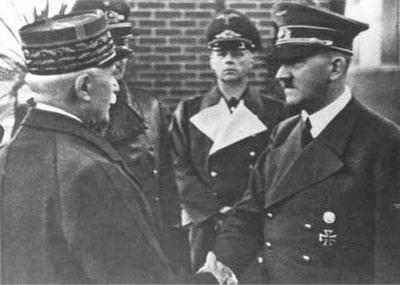 |
The previous German aristocratic structure had limited opportunities. With the aristocratic restrictions removed, many upwardly mobile and eager soldiers saw an opportunity to join and make an elite force in their own impression. Paul Hausser and Felix Steiner were given this unique opportunity to do what they wanted and encouraged this attitude. In a few years, they created a core for a military force that would ultimately prove itself not only militarily capable in large scale combat, but a force which could be relied upon for primary responsibility in military operations. This was grudgingly accepted by their greatest skeptics, the traditional German army. In their zeal to make their own armed military unit in the mixed politics of interwar Germany and a desire for political compromise and acceptance by the traditional armed forces, the Nazi elite had managed to let something different come about. The traditional German army dutifully followed Hitler's orders to hold no matter what at Stalingrad and they died for their adherence to strict Prussian military code. In contrast, Paul Hausser defied a similar direct order by Hitler and pulled out of Kharkov in 1943 to save several Waffen-SS panzer divisions from getting squandered uselessly by yet another of Hitler's detrimental military meddling. In some ways this core that became the Waffen-SS was the military tool of the Nazi party, but they also had an agenda, and mind, of their own.
~ Andy.
|
Want To Know More About Blitzkrieg?
Over the past few months we have added a massive range of articles
about Blitzkrieg to the website, to make it easier for people to find a
specific article we have put together this handy place.
Find out more about Blitzkrieg and Early-war here... |
Last Updated On Monday, March 7, 2011 by Blake at Battlefront
|
|
|